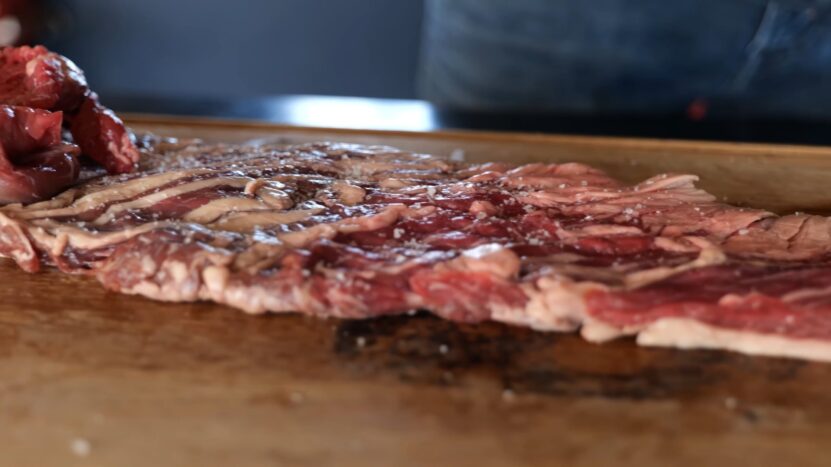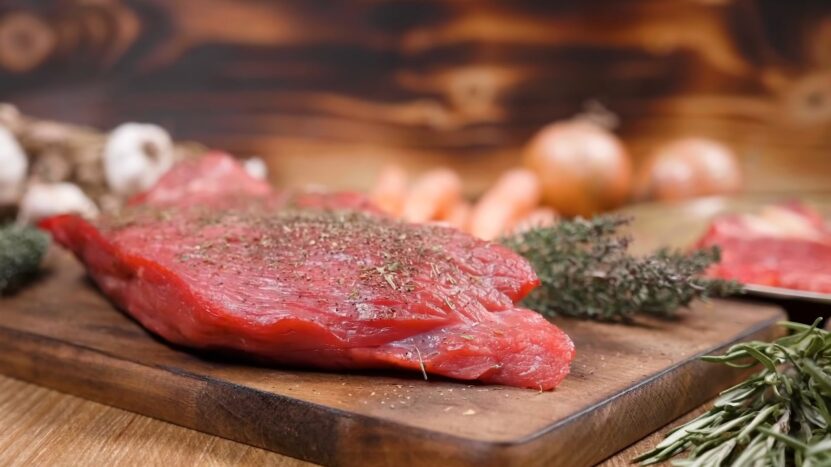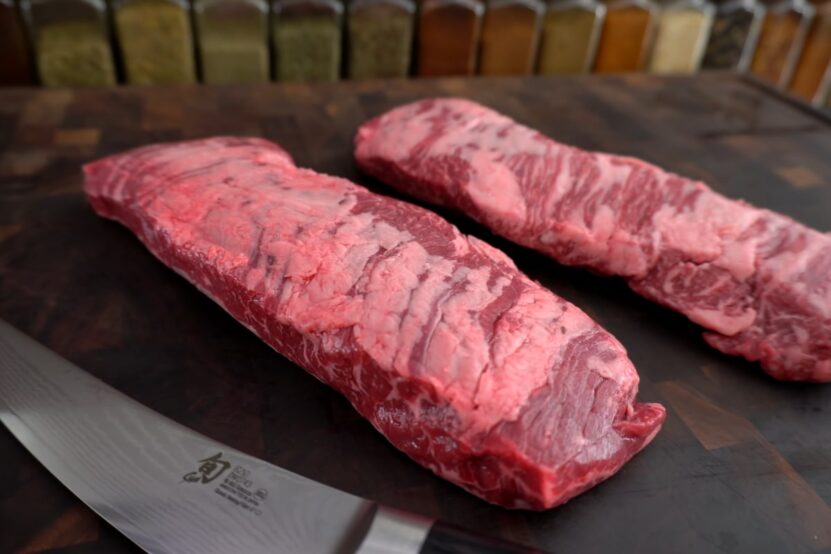When it comes to the world of beef cuts, there’s a lot to digest. From ribeyes to filets, each cut has its unique characteristics. Among these, hanger steak and skirt steak often cause confusion. Are they the same?
The answer is no, they’re not. Although they come from similar regions of the cow, there are several factors that set them apart.
Know Your Cuts

Knowing your beef cuts is not just about sounding knowledgeable at the butcher’s shop. It’s about maximizing flavor, texture, and value. Different cuts require different cooking methods, and using the wrong method can turn a potentially delicious meal into a disaster.
A cow is divided into various sections, each yielding different cuts of meat. From the chuck at the front to the round at the back, each section has its unique properties. The hanger and skirt steaks come from the belly and diaphragm areas, respectively, which is why they’re often compared.
Hanger Steak

Often referred to as the butcher’s steak, this cut was traditionally the cut that butchers would keep for themselves. It’s a hidden gem in the world of beef.
| Characteristic | Description |
|---|---|
| Cut Location | Near the diaphragm of the steer, hanging between the last rib and loin. |
| Texture | Coarse-grained, slightly tougher compared to some other cuts. |
| Flavor | Robust, beefy flavor with a hint of minerality. |
| Marbling | Limited marbling, with fat mainly concentrated on the outer edge. |
| Cooking Methods | Best suited for grilling, searing, or pan-frying to medium-rare or medium. |
| Tenderness | Moderately tender when properly cooked and sliced against the grain. |
| Uses | Often used in fajitas, stir-fries, salads, sandwiches, or as a standalone steak. |
| Preparation | Requires careful preparation, including removing the tough connective tissue. |
| Nicknames | Known as “hanging tender” or “butcher’s steak.” |
| Culinary Profile | Well-suited for those who enjoy strong beef flavors and don’t mind a chewier texture. |
What’s the Best Ways to Cook It?
Grilling or pan-searing are the most popular methods for cooking this cut. It’s essential to marinate it first to tenderize the meat and enhance its flavor. Once cooked, it’s crucial to slice it against the grain to ensure maximum tenderness.
Skirt Steak

This cut might be familiar to many as the classic choice for fajitas. It’s a long, flat piece of meat with a robust flavor profile.
| Characteristic | Description |
|---|---|
| Cut Location | Located in the plate section of the steer’s belly, with two distinct muscles: inside and outside skirt. |
| Texture | Coarse and grainy, with a slightly chewy texture. |
| Flavor | Intense, rich, and beefy flavor profile. |
| Marbling | Minimal marbling, with fat primarily along the edges. |
| Cooking Methods | Ideal for quick cooking methods like grilling, searing, or pan-frying. |
| Tenderness | Can be less tender if not cooked correctly and sliced against the grain. |
| Uses | Traditionally used in fajitas, tacos, and Asian stir-fry dishes, but versatile enough for various cuisines. |
| Preparation | Requires proper marination and careful cooking to enhance tenderness. |
| Nicknames | Often referred to as “fajita meat” or “Philadelphia steak.” |
| Culinary Profile | Well-suited for those who enjoy strong beefy flavors and prefer a chewier texture. |
How to Cook It?
Like the hanger, the skirt steak benefits from marination. It’s best cooked quickly over high heat, either grilled or seared. And, just like its counterpart, it’s vital to slice it against the grain to prevent it from being too chewy.
Comparing the Two: Hanger vs. Skirt

These steaks are distinct in flavor, texture, and best cooking methods.
Flavor and Texture
Hanger steak is often described as having a more intense beef flavor than the skirt. Its texture is tender, almost like that of filet mignon. Skirt steak, on the other hand, is beefier and can be a bit tougher due to its fibrous nature.
Availability and Price
Since there’s only one hanger steak per cow, it can be harder to find and slightly more expensive than the skirt. Skirt steak, being more popular, especially in dishes like fajitas, is more readily available and can be a bit more affordable.
Tips for Buying and Storing

Whether you’re buying hanger or skirt steak, it’s essential to know how to choose the best piece and store it properly.
What to Look For
When buying either cut, look for a bright red color with a good amount of marbling. This fat distribution ensures a flavorful and juicy steak. Avoid cuts that look gray or have a slimy texture.
Storing Your Cut
Both hanger and skirt steaks are best consumed fresh. If you need to store them, keep them in the refrigerator for up to two days.
For longer storage, consider vacuum-sealing and freezing them.
Cooking Mistakes to Avoid
Even with the best cuts of meat, things can go wrong in the kitchen. Being aware of common mistakes can ensure your steak is cooked to perfection.
Overcooking
Both hanger and skirt steaks are best-enjoyed medium-rare to medium. Overcooking can lead to a dry and tough cut, robbing it of its natural juiciness and flavor.
Always use a meat thermometer to ensure the right internal temperature.
Not Resting the Cut
After cooking, it’s crucial to let the steak rest for at least 5-10 minutes. This allows the juices to redistribute throughout the meat, ensuring a moist and flavorful bite.
Enhance the Flavor and Texture With Marination

Both cuts benefit immensely from marination. Not only does it infuse the meat with flavor, but it also helps tenderize it.
Best Marinades for Each Cut
For hanger steak, a combination of red wine, garlic, rosemary, and olive oil works wonders. The wine’s acidity tenderizes the meat, while the other ingredients complement its rich flavor.
Skirt steak, given its beefier profile, pairs well with bolder marinades. Think soy sauce, lime juice, garlic, and chili for a zesty kick, perfect for those fajitas.
Serving Suggestions
Once you’ve mastered the art of cooking these steaks, pairing them with the right sides and sauces can elevate your dining experience.
Perfect Pairings
Hanger steak, with its rich flavor, pairs beautifully with lighter sides like a fresh green salad or steamed vegetables. A red wine reduction sauce can further enhance its taste.
Skirt steak, given its robust profile, goes well with heartier sides like roasted potatoes or grilled corn. A chimichurri sauce can add a refreshing touch.
Wine and Steak – A Match Made in Heaven
When it comes to wine, a bold red like a Cabernet Sauvignon or Malbec can complement the deep flavors of both hanger and skirt steaks. If you’re in the mood for something lighter, Pinot Noir can be a delightful choice.
FAQs:
Are both steaks suitable for both grilling and smoking?
Yes, both cuts are great for grilling or smoking, depending on personal preference and available cooking time.
Why were they not prized for a long time?
They were not considered premium cuts and were often used for ground beef or kept by butchers for personal consumption.
Which one is more popular in restaurants and home kitchens nowadays?
Both hanger and skirt steaks have been gaining popularity in recent years, making their way into restaurants and home kitchens.
Is there a difference in weight?
Hanger steaks weigh significantly less than skirt steaks.
Why is hanger steak considered a rarer commodity?
There is only one hanger cut per cow, making it a rarer cut of meat.
The Bottom Line
The decision between hanger and skirt steak boils down to personal preference and the dish you’re preparing. If you’re a steak purist looking for a tender and flavorful cut, the hanger steak might be your best bet. Its unique taste and texture make it a favorite among many beef enthusiasts.
For those looking for a versatile and affordable option, skirt steak is a fantastic choice. It’s perfect for grilling, stir-frying, or making your favorite fajita recipe. In the end, both hanger and skirt steaks have their merits.
It’s all about understanding their characteristics and using them to their fullest potential in the kitchen.
